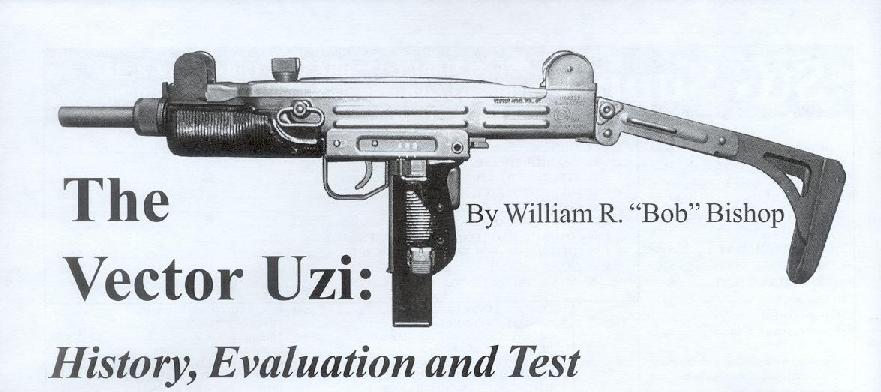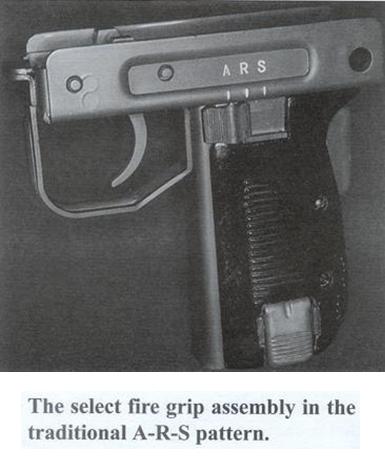
Vector UZI
 |
Vector UZI |

Many SAR readers have wondered over the past five years what ever happened to the lot of Group Industries registered UZI receivers that were sold at the Group Industries auction. Did someone purchase these valuable pieces of ordnance and “sit on them” until market conditions changed and a huge profit margin become realized?
Not really.
They were bought by Ralph Merrill, President of Vector Arms, and it simply took this long to find a high quality source of new parts to build them up into a finished product. He has finally done so and is now selling them on the fully transferable C3 market. As there has been so much talk about the Vector UZI, this article will answer many questions by providing a detailed history, evaluation and test of a regular production version...no special “hand finished” ringers here! The standard of comparison will be the world famous IMI 9mm UZI.
Finally, let me take all the suspense out of your mind. I have carried an UZI in a war zone for months (1996-97 in Bosnia, Croatia and Serbia) and also own the IMI version. While not being a total expert, I do have sufficient knowledge and real world experience to fairly test/evaluate one. Saying this, and with no financial interest in Vector Arms, I can unequivocally state the tested Vector UZI is the finest one I have ever used. Period.
Birth of the Receiver
The heart of the Vector UZI is its registered receiver. These started life in 1985-86 when the flats were stamped and folded by Michael Brown, at that time the President of Group Industries. This company had gained a reputation in the 1980's as a converter of the semi-auto IMI UZI into select fire. As the price of the IMI UZI increased and the supply became spotty, Michael conceived the idea of making his own US version and not being dependent on a foreign supplier. Further, he would be able to directly influence the quality and end up with a superior product. As an inside joke, the Group Industries UZI's were engraved with the model number HR4332. Mike selected this number as it was the House of Representatives law enacted in May, 1986 which banned newly manufactured machine gun ownership by private citizens.
To gain additional funding for this very ambitious project, Michael teamed up with Roger Small, head of Scattergun Technologies (And the old Automatic Weapons Company). Roger agreed to partially fund it for approximately $250,000 providing he (Roger) received specific delivery schedules and exclusive distribution privileges.
In the end, Group Industries could not meet the agreed upon terms and Scattergun Technologies sued for breach of contract. After a prolonged length of back and forth moves from both sides, Scattergun Technologies finally won a judgment against Group Industries in 1993. Meanwhile, Group sought protection from its creditors by filing for several reorganizations under Chapter 11. This only temporarily prevailed, however, and in early 1995 the creditors ordered the assets to be liquidated under Chapter 7. An auction was held on 24 August 1995 the likes of which has rarely been seen before (MAC auction in 1976) and probably not since.
Among the many items up for bid included forming/stamping dies, boxes of parts, several full automatic weapons, one WWII WC24 command car, two M5A1 light tanks and 3318 registered - and fully transferable - UZI receiver frames. There were nowhere near enough spare parts to complete these valuable receivers and some people wondered if the buyer had bought the proverbial "pig in the poke".
The mysterious high bidder was #221 who paid $265,000 for the 3318 UZI receivers along with an additional 109 Post-86 DS receivers. Including the 10% buyer's premium to the auctioneer, the total bill was $291,500; this meant the unit cost for all 3427 receivers was $85.06 each. The buyer's name was Marcos Garcia and he was the representative for one Ralph Merrill...President of Vector Arms.
Now that Vector Arms had just entered the UZI market in a big way, Ralph had to figure out: 1) where to access a very large supply of new parts to complete these 3318 fully transferable receivers; and, 2) where to find a production facility to assemble the Vector UZI? These two items became a world class nightmare.
Sourcing of Parts
 Ralph
first contacted Israeli Military Industries (IMI) in January, 1996, to inquire
about the parts/production necessary to finish the receivers. Though their UZI
production lines had been shut down several years earlier when moved from Tel
Aviv, it was expected that substantial numbers of parts would remain in
inventory and thus be available for Vector's use. Incredibly, IMI had none
available as they had been sold off or consumed by the world market. Further,
they were not interested in reopening the production lines for a relatively few
number of SMG's.
Ralph
first contacted Israeli Military Industries (IMI) in January, 1996, to inquire
about the parts/production necessary to finish the receivers. Though their UZI
production lines had been shut down several years earlier when moved from Tel
Aviv, it was expected that substantial numbers of parts would remain in
inventory and thus be available for Vector's use. Incredibly, IMI had none
available as they had been sold off or consumed by the world market. Further,
they were not interested in reopening the production lines for a relatively few
number of SMG's.
In February, 1997 he contacted the other major UZI manufacturer - Fabrique Nationale (FN) of Herstal, Belgium. FN had been famous for years regarding its high quality manufacturing processes and had supplied numerous military/police forces of several nations. Unfortunately, as with IMI, no parts or production services were available. Their production line had been shut down in the 1980's and the ability to restart it was not economically feasible as tooling, jigs, dies, etc. had been sold, transferred or outright destroyed.
During March, 1997,Ralph
contacted Distraco SA (IMI-Europe) headquarters in Brussels, Belgium. He hoped
they possessed a suitably large inventory of spare parts and the supporting
production facilities to finish the Group Industry receivers This, too, was
fruitless. They did have a good number of parts but could not support any UZI
production. Distraco SA could install parts and repair existing firearms but did
not possess the facilities to perform initial buildup of the receiver. The
equipment needed to install barrel trunnions, rear plates, sight brackets, etc.
did not exist. At this point, Ralph felt pretty down. It appeared he would have
to undertake the exact events which led to Group Industries' downfall... 1) set
up his own production facility; and, 2) make the parts himself. Technically it
was feasible, but financially it was a prohibitive process. Thus, in the Spring
of 1997, it was decided that Vector Arms would set up their own production
facilities in Utah (more on this later). Further, as this would push them to the
limit, the location of existing new UZI parts was now imperative.

And then luck smiled...
In July, 1997, Ralph heard that South Africa could be a salvation regarding parts. During the late 1970's the Pretoria based firm of Lyttleton Engineering had quietly manufactured thousands of UZI's to supply South African forces engaged in the Rhodesian war. Upon conclusion of this war and creation of Zimbabwe, the demand for these UZI's had ceased. Consequently, over 5000 brand new Lyttleton made SMG's were carefully stored in a South African warehouse. Yes, the government would sell them but was not interested in dismantling them into parts kits - someone else must do that. Negotiations to acquire these new UZI’s and get them stripped down would take the next 1 1/2 years.
An UZI is comprised of 85 parts and the Lyttleton UZI's could provide 77. This is because the balance (7, not counting the receiver) are welded/built into the receiver in such a way that they would be destroyed during removal. Thus, where to acquire the barrel nut latch housing, front sight bracket, bayonet lug, foregrip lug, pistol grip lug, rear plate and rear sight bracket? Perhaps a final foreign trip could locate these seven missing parts.
In September, 1998, Ralph
visited the Croatian firm of RH-ALAN, which was producing an UZI clone - the ERO
9 - and amenable to providing the seven missing parts. But...they wanted
$500,000 to do so. Additionally, some of these parts were investment cast and
somewhat suspect regarding long term use/wear which the American shooter would
expect of a "new production" fully transferable SMG. Ralph thanked them very
much and decided he would make these seven parts himself. There was no other
solution.

At this same time in September, 1998, the South Africans finally shipped the 5000 Lyttleton UZI's to Switzerland where they were carefully disassembled into the necessary 77 parts by a respected Swiss firm. The US import permit was easily approved and the first 60 kits landed in Utah via Delta Airlines in February, 1999, with the bulk arriving by sealift in May.
After four years of diligent searching, Vector Arms finally had 77 of the 84 new parts they needed. Now, they were going to make the additional seven parts themselves and set up full production facilities.
Vector's Manufacturing Process
As mentioned earlier, Ralph had decided in the spring of 1997 to set up production facilities himself when IMI and FN did not come through. To learn how to make an UZI, he located Mike Brown and asked him to conduct an "UZI school" and teach how it is done. As Mike had remained true to the product and wanted “his” UZI's to be completed and distributed to the American market, he agreed to take Ralph under his tutelage. If Group Industries was dead, then Vector Arms would finish the job.
Over a ten day period in the summer of 1997, Mike taught Ralph everything there was to know about correctly building an UZI. From the initial stamping to the final finishing, he covered it all. To validate his skills, Ralph built ten UZI's and had Mike carefully examine each one. They were equal to, or better than, those of IMI and FN. In fact, the Vector UZI is built to the highest commercial standards and exceeds that of any milspec version. Surface finish is much finer, edges are carefully deburred, welds are correctly dressed down, forming marks left by the stamping dies are removed via special tooling, etc. After Ralph graduated the school he went back to Vector Arms and taught his crew how to do it to commercial standard.
With this production knowledge and the 77 Lyttleton made parts in hand, Vector Arms manufactured their own seven parts to complete the set. The rear sight bracket is formed from 14 gauge steel with a stamping die formerly owned by Group Industries. Also, stamping dies were built to form the front sight bracket, while the remaining five parts were machined via CNC equipment from a steel billet. At long last, the registered receiver and all 84 parts necessary to make a true UZI were available.
Copyright © 2002-2017, UZITalk.com
International copyright laws
DO apply to
Internet Web Sites!
All Rights Reserved.
Last Modified: May 28, 2017
Contact:
librarian@uzitalk.com